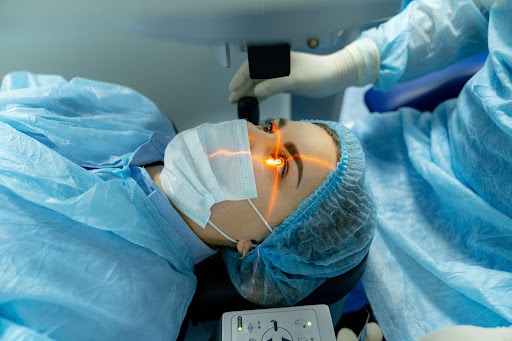Eye Care
How Does SMILE Eye Surgery Work?

by admin
27th December 2023
6 minutes read
Laser eye surgical procedures are becoming increasingly popular due to their high success rate and quick post-operative healing and recovery. These are minimally-invasive (painless, bloodless, and cause less trauma) procedures that correct refractive errors like myopia (nearsightedness), hyperopia (farsightedness), astigmatism (abnormal curvature of the cornea), and presbyopia (a condition that is characterized by the eyes’ inability to focus nearby objects). Your dependency on eyeglasses and contact lenses is greatly reduced, boosting your confidence. SMILE is one such laser eye surgery that permanently corrects your refractive error and stabilizes your vision. It is a safe and effective eye surgery being opted by many individuals today.
Let us explore more about SMILE eye surgery and how it works in stabilizing your eyesight.
How Does SMILE Eye Surgery Works?
SMILE (Small Incision Lenticule Extraction) eye surgery is a laser-assisted procedure that aims to improve your vision. Refractive errors like myopia, hyperopia, astigmatism, and presbyopia cause a change in your vision which makes it difficult for you to read, write, drive, and perform other daily routine activities. This significantly affects your quality of life.
Eyeglasses and contact lenses are considered an option for many but with their own drawbacks. On the one hand, eyeglasses are aesthetically not appealing, which lowers your confidence. On the other hand, using contact lenses is a tedious process due to the risk of allergies and infections.
Currently, laser eye surgery such as SMILE is the solution to all your problems that permanently improves your vision, thereby reducing your dependency on eyeglasses and contact lenses.
-
The principle behind SMILE eye surgery
- Your vision depends on your cornea (the transparent part of your eye that covers the pupil and iris, that allows light to enter inside) and lens that focus a clear image of the objects around you, onto your retina (light sensitive layer at the back of your eye).
- This happens due to the bending (refraction) of light rays to form a sharp image on your retina.
- Abnormal alterations in the shape of your cornea leads to the image not being focused properly thus making your vision blurry.
- SMILE surgery uses a femtosecond laser to correct the abnormal curvature of your cornea.
- It creates a lenticule (a disc-shaped piece of the cornea) within the different layers of the cornea.
- This lenticule is then extracted (removed) through tiny incisions measuring less than 4 mm (the name given to the surgery is because of the lenticule created and size of incision).

-
Pre- procedure
-
-
- SMILE is relatively a safe procedure with minimal post-op complications.
- It is an outpatient (does not require any hospitalization) procedure that takes less than 30 minutes for both the eyes.
- Your eye surgeon evaluates your eyes to check your refractive error and the overall health of your eyes.
- Various eye examination tests are conducted 2 to 3 days prior to the procedure.
- Slit examination test- to check overall eye health.
- Vision test- to check your refractive error and prescription stability.
- Pachymetry test- to check and evaluate the corneal thickness.
- Eye examination to check the pupil size.
- These eye measurements help the surgeon program the computer-based laser used during SMILE surgery.
- Your detailed medical history is recorded to rule out diabetes (high blood sugar levels), hypertension (increased blood pressure), and other blood disorders.
- You need to inform your surgeon about your habits like smoking and alcohol, which help determine the course of the procedure and avoid post-op complications.
- You are advised to discontinue your contact lenses 2 weeks before your procedure to avoid corneal swelling that could affect your eye measurements.
-
-
Procedure
-
- Your eyes are thoroughly washed with an antiseptic solution to remove any contaminant to minimize the infection risk.
- You will be given anesthetic eye drops to numb your eye; hence you will not feel any pain or discomfort during the whole procedure. SMILE eye surgery does not hurt, but you will likely feel some pressure due to the instruments used (eye holder and suction).
- You would be completely awake during the entire procedure.
- Your eyes are held in position with an eye holder, with the cornea being raised and flattened with a suction.
- A femtosecond laser is focused on your cornea to create a lenticule (a disc-shaped piece of tissue).
- A small incision (less than 4 mm) is carefully made in the corneal layers.
- The lenticule is extracted through this incision which reshapes your cornea.
-
Post-Procedure
-
- Post-op instructions are given by your surgeon that should be followed for quick recovery.
- Eye drops are prescribed accordingly:
- Antibiotics- to prevent infections
- Lubricating- they help to reduce the dryness of the eyes
- Steroid- these drops reduce inflammation and swelling
- Anti-inflammatory- to reduce inflammation and redness around your eyes
- Your surgeon will cover your eyes with an eye shield that has to be used at night while sleeping. These shields are used to protect your eyes from accidental trauma.
- Arrange someone to drive you back home since you would have blurred vision for the next 24 to 48 hours post-surgery.
- Follow the below-given guidelines for faster healing
- Avoid excess screen time for at least 24 to 48 hours since this may strain your eyes and cause redness.
- Avoid washing your face or having a head bath because the soap and other chemicals may cause redness and eye irritation.
- Avoid excess sun exposure for at least 2 weeks to prevent corneal scarring.
- Avoid cooking for a minimum of 2 weeks because the heat and steam during cooking can irritate your eyes and lead to accidents due to blurred vision.
- Avoid eye makeup for 2 to 4 weeks since the chemicals in the products can cause allergic reactions, and the eye brushes used harbor infection-causing bacteria.
- Avoid strenuous exercises and lifting heavy objects for at least 2 weeks. This puts unnecessary pressure on your eyes.
- Avoid swimming and other water sports for 4 to 6 weeks since the water droplets may harm your lens, and cause irritation.
- Wear protective sunglasses when outdoors to prevent the harmful UV rays from affecting your eyes.
- Attend all your post-op follow-up appointments without fail.
- Post-surgical recovery after SMILE eye surgery usually takes around 2 to 4 weeks.
- You are likely to have clear vision right from the next day, however, complete vision stabilization may take up to 2 to 3 months.
Takeaway
SMILE laser eye surgery is a safe and effective vision correction procedure. It uses a femtosecond laser to create a lenticule extracted through a small incision. This reshapes your cornea, which corrects the abnormal corneal curvature, thus focusing images clearly onto your retina. Owing to its minimal postoperative complications and quick recovery, SMILE is the preferred choice for vision correction.
Consult our team of highly qualified and skilled eye surgeons at Medfin if you are experiencing vision problems. Get rid of those boring eyeglasses and tedious contact lenses with our latest laser-assisted eye procedures.
Disclaimer:
The content on this site is the copyright of Medfin and is intended for informational and educational purposes only. This should not be considered as a substitute for medical and surgical expertise. Results from any treatments or surgeries are subjective to an individual patient and the type of procedure/ surgery performed. Please seek professional help regarding any medical concerns. Medfin will not be responsible for any act or omission arising from the interpretation of the content present on this page.
CATEGORIES
- ACL Reconstruction
- Anal Fissures
- Anal Fistula
- Appendicitis
- ASK A DOCTOR
- Benign Prostatic Hyperplasia
- Breast Lump Excision
- Cataract
- Circumcision
- Conditions & Diseases
- Cosmetology
- Covid-19
- Cure
- Endocrinology
- ENGLISH VIDEOS
- Eye Care
- Gallstones
- General Surgeries
- Government Schemes
- Gynaecology
- Gynecomastia
- Gynecomastia
- Health
- Health Insurance
- Hernia
- hindi
- Hip Arthoscopy
- Hip Replacement
- Hip Replacement Surgery
- Hydrocele
- Kannada
- Kidney Stones
- Knee Arthroscopic
- Laparoscopic
- LASER
- Latest Treatments
- Lifestyle
- Liposuction
- Medfin Stories
- Medicine
- Nephrology
- Ophthalmology
- Orthopaedic
- Paraphimosis
- Patient Testimonials
- PCL Reconstruction
- Phimosis
- Piles (Hemorrhoids)
- Pilonidal Sinus
- Proctology
- Prostate Artery Embolization
- Rhinoplasty
- Second Opinion
- Total Knee Replacement
- Uncategorised
- Urology
- uterine artery embolization
- Uterine Fibroids
- Varicocele
- Varicose Veins
- Vascular
- VIDEOS






